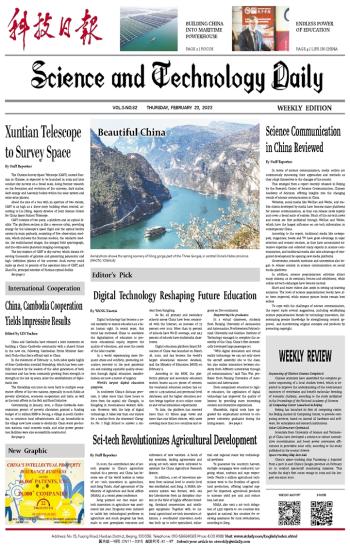
 Endless Power of Education
Endless Power of Education Building China into Maritime Powerhouse
Building China into Maritime Powerhouse Xuntian Telescope to Survey Space
Xuntian Telescope to Survey Space Beautiful China
Beautiful China Science Communication in China Reviewed
Science Communication in China Reviewed Digital Technology Reshaping Future Education
Digital Technology Reshaping Future Education China, Cambodia Cooperation Yields Impressive Results
China, Cambodia Cooperation Yields Impressive Results WEEKLY REVIEW
WEEKLY REVIEW Sci-tech Revolutionizes Agricultural Development
Sci-tech Revolutionizes Agricultural Development New Graphic
New Graphic WECHAT ACCOUNT
WECHAT ACCOUNT
The Chinese Survey Space Telescope (CSST), named Xuntian in Chinese, is expected to be launched in 2023 and later conduct sky surveys on a broad scale, doing frontier research on the formation and evolution of the universe, dark matter, dark energy and heavenly bodies within the solar system and extra-solar planets.
About the size of a bus with an aperture of two meters, CSST is as high as a three-story building when erected, according to Liu Jifeng, deputy director of Joint Science Center for China Space Station Telescope.
CSST consists of two parts, a platform and an optical facility. The platform section is like a resource cabin, providing energy for the telescope's space flight and the optical facility carries its main payloads, consisting of five observation modules, which includes the Xuntian module, the terahertz module, the multichannel imager, the integral field spectrograph, and the extra-solar planetary imaging coronagraph.
The key mission of CSST is sky survey, which means observing thousands of galaxies and generating panoramic and high -definition photos of the universe. Such survey could make up about 70 percent of the operation time of CSST, said Zhan Hu, principal scientist of Xuntian optical facility.
Li Ran, researcher at National Astronomical Observatories of the Chinese Academy of Sciences, said that 30 detectors are installed in the Xuntian module, with a total of 2.5 billion pixels. Filters on 18 detectors could capture images of heavenly bodies at different bands, and the other 12 detectors are used to conduct slitless spectrographs, with each exposure acquiring the spectral information of at least 1,000 heavenly bodies. During the survey period, the Xuntian module will cover 40 percent of the entire sky and collect high-quality data of nearly two billion galaxies.
CSST is also good at detailed observation, and the other four modules of the optical facility part are all used for that purpose. Specific observation, like extra-solar planet probes, will be conducted.
The China Space Station Tiangong will act as the home port of CSST, but the telescope will fly independently in the same orbit as the space station, and keep a significant distance from it during its normal observations. When CSST needs supply or maintenance, it will dock with the space station, which not only guarantees its normal operation in its ten-year lifetime, but also extends its in-orbit service time.

 Next
Next



